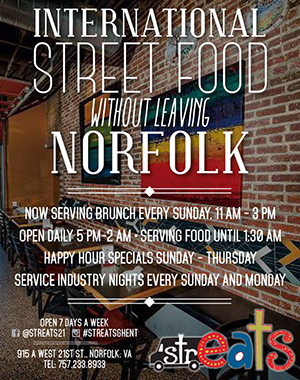Article by Debra Freeman
Lead graphic illustration by Kyle Melendez and Elena Bundy
Drive too quickly along the intersection of Crittenden Road and Macedonia Drive in Suffolk, and you might miss the historic marker located on the side of the road. Placed on a narrow strip of grass, the unassuming marker belies that this area was once where the oldest self-sustaining African-American oyster community in Hampton Roads was located. The rich history of Hobson as a self-sufficient oystering community founded by former slaves is difficult to envision, as today midcentury homes are built over the history of an enclave that thrived for decades in spite of racist historical barriers.
According to oral history, a group of free slaves used their savings from oystering, purchased a plot of land in Nansemond County, and eventually became known as Hobson (the area was named after a popular naval hero of the Spanish American War, Richard Pearson Hobson).
Karla Smith, author of The River Binds Us, A Story Told by the People of Crittenden, Eclipse, and Hobson, says the Hobson residents believe their town “grew from a settlement of former slaves, perhaps seven of them, from Carter’s Grove plantation near Williamsburg.”
After the Civil War, oystering was a profitable industry in Hampton Roads because there was a market for seafood, both in the north and south because of the increase in coastal shipping by steamboat, and railroads opened new markets for Hampton Roads oysters. Soon, oyster houses in Suffolk were shipping close to 75 thousand bushels of oysters each year. In 1869, the Auditor of Public Accounts in Virginia estimated there were more than 640,000 acres of oyster beds with a value of around ten million dollars annually. Over the years, because of the increasing profitability of oystering, white watermen were attracted to the area and moved to nearby Crittenden and Eclipse on Chuckatuck Creek, but largely did not settle in Hobson.

To begin your culinary journey visit chefva.com or click the flier above.
By 1870, the settlement grew to nearly 60 African-American households, and a post office application was submitted in 1898. According to census records in that same year, there were 16 black oystermen listed as head of household, by 1899, land records list 28 parcels of land owned by blacks varying in size. Fast forward to 1910, and out of the 85 African-American households listed, 43 listed they made their livelihood on the water.
In 1920, 136 people in Hobson were employed, and most earned their living as watermen, with the largest amount working in the oyster industry (25). An additional ten were listed as oystermen with their own boats, three men were oystermen in hired boats, six worked as laborers on oyster boats, five worked as laborers in oystering, and one was a boatman in oyster boats. Other men worked on the water in various capacities, including several boatmen laboring on freight boats.
As recently as the 1950’s, about 60 boats worked out of Chuckatuck Creek, and three oyster houses and two marine railways served the local industry. By this point, residents of Hobson were thriving; they built their own boats and families maintained their own oyster beds, passing them from one generation to another.
In the first half of the twentieth century, it was an easy process to acquire oyster beds. Ernest Wilson, a former resident of Hobson, declared that all a person had to do was go out in the river and place sticks in the claimed area, apply to the state, an official would inspect the site, and award the oyster grounds to the applicant.
According to the application to register Hobson on the National Registry of Historic Places, George Hatten, also a former resident of Hobson, recalled that during the oyster season, “everyone who wanted work was employed in the community. No one had to go out and look for a job. Women who wanted to work could find employment shucking oysters. Blacks did not have to go anywhere to look for jobs. All they had to do was learn the trade of catching oysters…we pass it on from one generation to another.”

For more on the inspired street food at Streats, visit them online HERE or click the flier above!
The self-sufficiency of the town was evident in more than a monetary way; throughout its existence, there are examples of how this community decided to create opportunities for themselves in spite of outside obstacles. Their desire to create something for themselves without the restrictions of race and outside agency and influence is an underlying theme that runs throughout the establishment of the community.
In 1937, the new East Suffolk High School for blacks created new educational opportunities; previously students attended school in a three room schoolhouse, which was indicative of African-American schools throughout the state. Residents of Hobson were able to attend the new school, but needed to find a way for students to travel to the school, which was located 17 miles away. According to the school board, there was no funding available for a bus. In 1937, Hobson parents combined resources and purchased a bus and hired a driver.
Other examples of extraordinary buy-in include when locals decided to build their own artesian well system in 1947, so as not to depend on renting water from a white well owner, and the newly created system allowed each home to have indoor plumbing. Each resident agreed that each household would pay a fee of $25.00 a year, and the Hobson chapter of the Masons, a fraternal institution, also raised money for the new system. Additionally, the village of Hobson did not have street lights until 1961 when the community paid for them and had them installed.
As resilient as this community was, the impact of outside forces began to affect the livelihood of most in this area. In 1968, the Army Corps of Engineers built a dam across Carter’s Cove Creek, which was Hobson’s direct outlet to Chuckatuck Creek. The creek flowed out to the James River; many people had oyster beds in Carter’s Cove and kept their boats there.
Typically, the Army Corps of Engineers has a multi-step process in order to grant permitting, including public hearings and public notice, which often takes a significant amount of time to approve a project.
No public hearings or notice of any sort was given to residents, and the dam which closed Carter’s Cove Creek was built. Boats had to be moved and docked elsewhere. Oyster beds which provided income to families were destroyed.

For more on Wasserhund’s German style beer with a Beach KICK, visit them online at wasserhundbrewing.com or click the flier above.
In another purposeful blow to this vibrant community, it was discovered that the Allied Chemical Plant in Hopewell had been dumping kepone, a potentially cancer-causing chemical, into the James River. Ingestion of kepone may lead to cancer, and those exposed to kepone developed severe neurological symptoms, known as the kepone shakes, as the chemical caused tremors that altered one’s walk, caused changes in behavior, weight loss, and impotence. By late 1975, Virginia Governor Mills Godwin, Jr. closed the James River to commercial fishing from Richmond to the Chesapeake Bay. The ban lasted for 13 years.
Rockfish and croaker in the James River and Chesapeake Bay still contain excessive levels of the pesticide, and Michael Unger, an associate professor at the Virginia Institute of Marine Science noted, “the fact that 65% of fish still have reportable kepone concentrations shows just how difficult it is to rid an ecosystem of a persistent toxic chemical.”
Wilson remarked that people stopped catching oysters around Hobson in the late 1980’s because there were so few oysters left, and oystermen had to travel an extra eighteen miles along the James River to the Rushmere area. He said, “They cut the Squash Channel, the new channel coming by Rushmere. That is where all the oyster beds were. When the tides came down, they came down so swiftly that oysters do not get a chance to feed back in our area. The tide wiped out the oysters in the James River Bridge area and then it finally got into the Chuckatuck Creek and Nansemond River. We used to depend on that area where the James River Bridge is.”
The argument could also be made that the increase in professional and educational opportunities for African-Americans grew to a point where working on the water was a skill that would eventually become lost for these families; in addition, as Hampton Roads became more connected via roads and bridges, it would have been a natural progression for families to move out of the community. However, it cannot be overlooked that the purposeful dumping of chemicals along with the dam across Carter’s Cove Creek caused irreparable damage to this once burgeoning area.
The question of what could have been still remains; one has to wonder what would have happened if those in Hobson could have continued to create their own opportunities. It is impossible to answer, but we can honor their memory by recognizing their efforts to navigate in a world that held little to no regard for their economic well being. Their courage to create a place for themselves against all odds and take part in the American dream should be celebrated with more than a marker along a roadside.







2 Comments
Thank you for the article. It was great informative read. Never considered the trials and $$$ behind creating a community.
I am a 7th generation in the Historic Hobson Village. My 100 year old Mother has been faced with a ongoing battle with defending her land in court for the past 5 years. I am reaching out to you a public cry on her behalf . 757-685-1730